Swimwear fabrics aren’t just a matter of style—they’re the secret ingredient behind speed, comfort, and durability in the water. From Olympic athletes chasing milliseconds to dive instructors logging hours underwater, the right material can make or break performance. What fabric qualities ensure a winning combination of stretch, recovery, chlorine resistance, and hydrodynamics? top swim fabrics blend high-tenacity nylon or polyester with PBT for elasticity, use tight knit constructions (e.g., tricot or warp-knit) at 180–250 gsm for balanced compression and drag reduction, and incorporate UV and chlorine-resistant finishes to safeguard longevity. Picture a competitive swimmer slicing through the pool in a suit that hugs every muscle without sagging, then imagine that same suit repelling chlorine day after day—behind those capabilities lie precise fiber blends, knit geometry, and performance finishes. Stick around—we’ll dive into each technical factor, backed by data and critical insights, to help you specify the ideal swimwear textile.
What Fiber Types (Nylon, Polyester, PBT) Offer the Optimal Balance of Stretch, Recovery, and Durability?
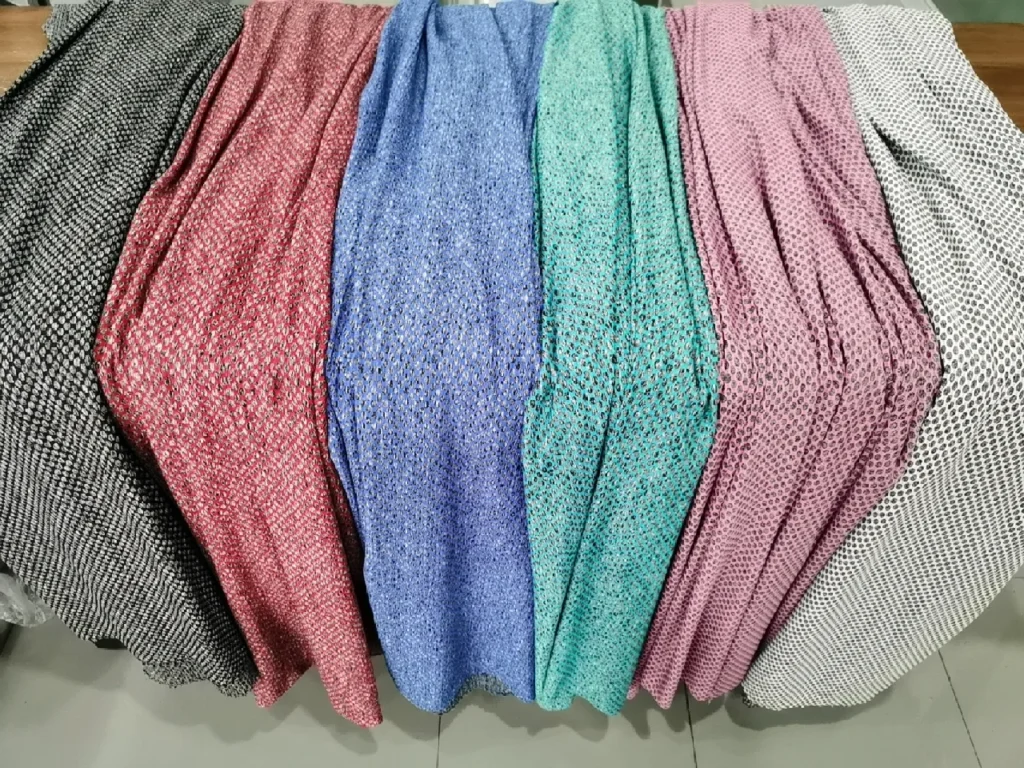
High-performance swimwear relies on blends of nylon or polyester with PBT (polybutylene terephthalate) to achieve the ideal mix of elasticity, shape retention, and long-term strength. Nylon/PBT (80/20) delivers 40–60 % elongation, >95 % elastic recovery after 50 stretch cycles, and moderate chlorine resistance, while Polyester/PBT (75/25) yields 30–50 % elongation, >90 % recovery, and superior UV and chlorine stability. These fiber combinations ensure a snug, supportive fit that won’t bag out or degrade quickly under sun, salt, or pool chemicals.
Fiber Chemistry & Blend Performance
Base Polymer Properties Property Nylon (PA6.6) Polyester (PET) PBT Tenacity (cN/dtex) 33–44 27–33 25–30 Moisture Regain (%) 4–5 0.4 0.2 Modulus (GPa) 1.0–1.5 1.2–1.8 0.5–0.8 UV Stability Moderate High High Chlorine Resistance Moderate Low Excellent
Blend Ratios & Mechanical Trade-Offs Blend Elongation at Break (%) Elastic Recovery @15% Strain (%) Chlorine Strength Retention @100 h (5 ppm) 80 Nylon / 20 PBT 50–60 >95 80–85 % 75 Poly / 25 PBT 30–50 90–92 90–95 %
Why PBT Matters
- High Elasticity & Recovery: PBT’s break elongation (\~350 %) and nearly full recovery make it the “spring” in each blend, preventing sagging.
- Chemical Resistance: Excellent resistance to chlorine and UV, preserving overall blend performance.
Critical Lens:
- Nylon Hand-Feel vs. Polyester Stability: Nylon/PBT blends feel softer and more luxurious but require robust anti-chlorine finishes. Polyester/PBT sacrifices some stretch for better long-term color and strength retention—ideal for suits exposed to harsh sun or saltwater.
- Finish Dependency: Both blends benefit from hydrophilic and anti-chlorine treatments; over-finishing can stiffen the hand, so formulations must be carefully optimized.
By selecting the right nylon/PBT or polyester/PBT blend, swimwear designers can tailor their fabric’s stretch, recovery, and durability to match everything from Olympic-level compression suits to rugged open-water gear—ensuring that every swimmer stays supported, streamlined, and confident in the pool or ocean.
How Do Fabric Stretch and Elastic Recovery Impact Fit, Compression, and Hydrodynamic Performance?
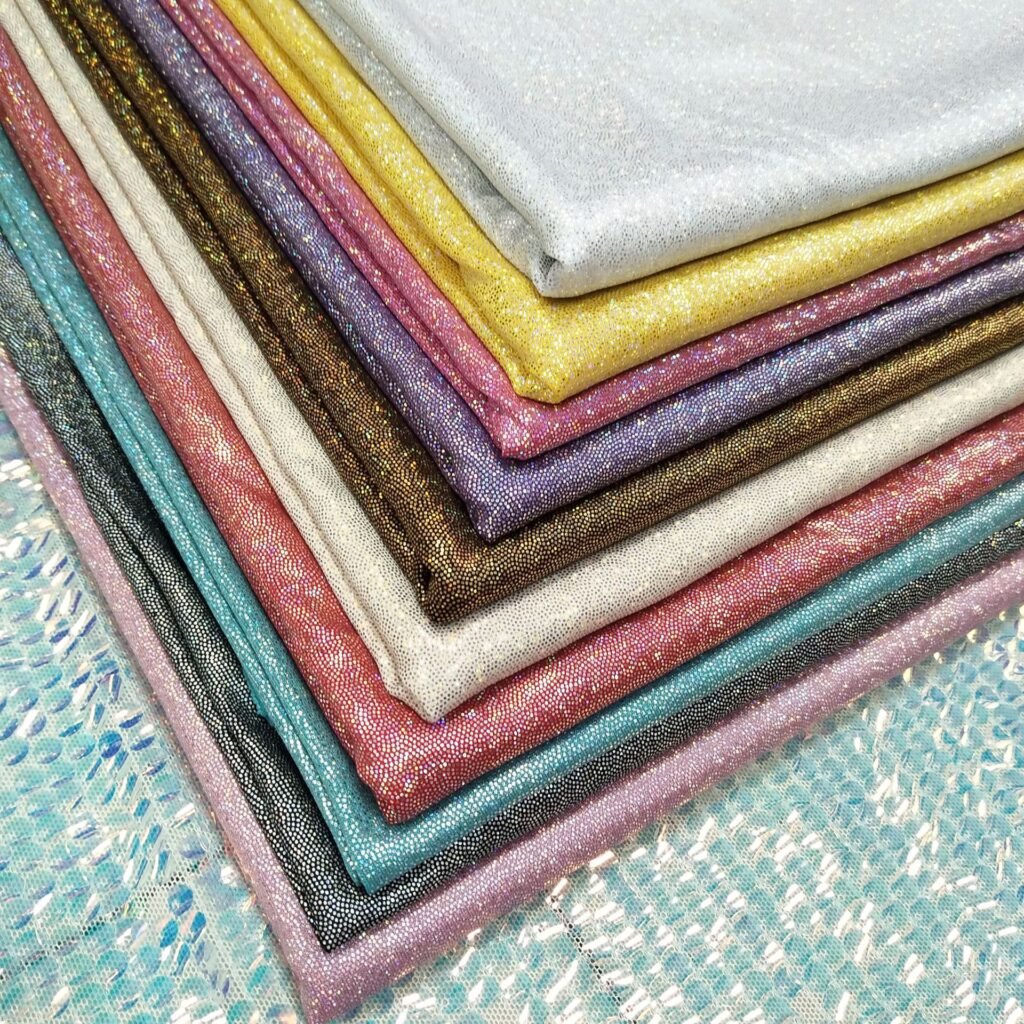
Fabric stretch determines how much the material can elongate to fit body contours and allow freedom of movement—ideal swim fabrics exhibit 30–60% elongation at break. Elastic recovery measures how well the fabric snaps back after stretching; world-class swimwear achieves >90% recovery after 50 cycles at 15% strain, ensuring sustained compression and preventing sagging. Proper compression (10–20 mmHg) streamlines the body, reducing drag by up to 7%, while reliable recovery preserves that hydrodynamic advantage throughout repeated strokes and races.
Stretch Metrics & Hydrodynamic Effects
Key Performance Indicators Parameter Competitive Specs Impact Elongation at Break (%) 30–60 Freedom of movement vs. targeted compression Elastic Recovery @15% Strain (%) ≥90 Maintains shape, prevents “bagging” Fatigue Resistance (50 cycles) ≥85% recovery Longevity of fit under repeated load
Compression Levels & Drag ReductionCompression Zones:
- Thighs: 15–20 mmHg for muscle stabilization.
- Core: 10–15 mmHg to streamline swimmer profile.
- Drag Coefficient Impact: Compression (mmHg) Drag Reduction (%) 0 (no compression) 0 10 4–5 20 6–7
Fabric Weight vs. Dynamic Stretch GSM Range Elongation (%) Recovery (%) Application 140–160 50–60 90–95 Racing suits 180–200 40–50 92–96 Sprint/training suits 200–250 30–40 95–98 Open-water & dive
Critical Lens:
- Over‐stretch fabrics can feel loose under water pressure; under‐stretch restricts stroke mechanics. Brands should verify these metrics via both laboratory cyclic tensile tests and in-water fit trials to ensure the fabric retains compression and hydrodynamic benefits across real-world use.
Which Knit Constructions and Fabric Weights Deliver Ideal Compression, Support, and Drag Reduction?
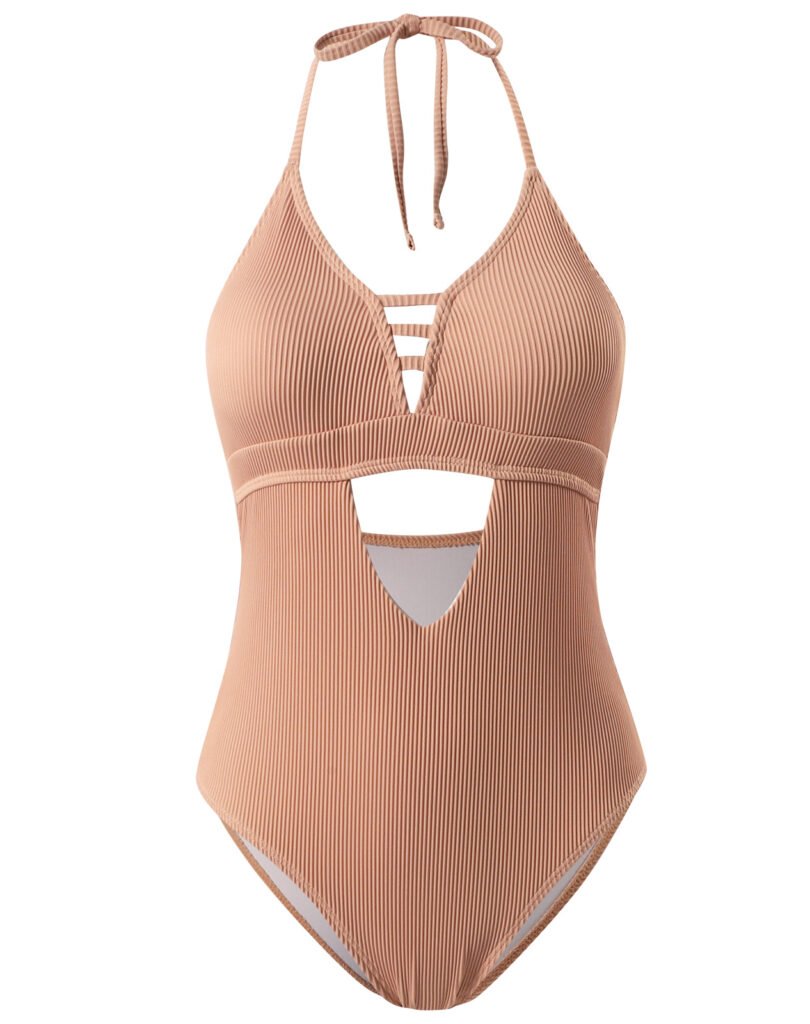
High-performance swimwear uses tricot warp‐knits and double‐knit interlocks engineered at 180–250 gsm to balance stretch, compression, and minimal water uptake. 2×2 rib tricot at 180 gsm offers 20 % crosswise stretch and moderate compression (10 mmHg), reducing drag by \~5 %. Interlock knits at 220 gsm provide balanced bi‐directional stretch (25 %) and higher recovery for full‐body suits, cutting drag by \~7 %. Micro‐tricot (140–160 gsm) maximizes low drag for racing, while heavier 250 gsm knits ensure warmth and abrasion resistance for open‐water use.
Knit Architectures & Performance Profiles
Tricot Warp‐Knits
- Structure: Single‐bar 2×2 rib or herringbone lapping gives crosswise stretch and lengthwise stability.
- Performance: Weight (gsm) Stretch W/L (%) Recovery (%) Drag Reduction (%) 140–160 15/5 92–95 8–10 180–200 20/5 90–94 5–7
Double‐Knit Interlock
- Structure: Fully interlocked loops on both faces for bi‐directional elasticity.
- Performance: Weight (gsm) Stretch W/L (%) Recovery (%) Application 200–220 25/15 95–98 Full suits, training 220–250 30/20 96–99 Open‐water & dive
Micro‐Tricot & Fast Racing Knits
- Features: Finer denier yarns (<1 D), tighter gauge (30 gauge) create ultra‐smooth, hydrophobic surface.
- Specs: 140 gsm, 12 % water uptake, drag reduction up to 12 %.
Weight vs. Use Case Knit Type GSM Range Primary Benefit Typical Use Micro‐Tricot 140–160 Maximum low‐drag Racing suits Tricot Rib 180–200 Balanced compression vs. stretch Sprint/training suits Interlock 200–250 High support & recovery Full‐body & open‐water Heavy Duty Tricot 250+ Insulation & abrasion resistance Dive & triathlon suits
Critical Lens:
- Drag vs. Durability Trade‐Off: Lighter knits reduce drag but can pill or snag; heavier knits last longer but slow swimmers slightly.
- Panel Engineering: Strategic use of different knits (e.g., micro‐tricot on thighs, interlock on torso) can optimize performance zone by zone, rather than relying on a single fabric throughout.
By selecting knit structures and fabric weights tailored to each swimwear category—racing, training, open‐water, or dive—you ensure athletes and enthusiasts alike experience the perfect synergy of compression, support, and hydrodynamic efficiency.
What Role Do Chlorine, Saltwater, and UV Resistance Play in Fabric Longevity?
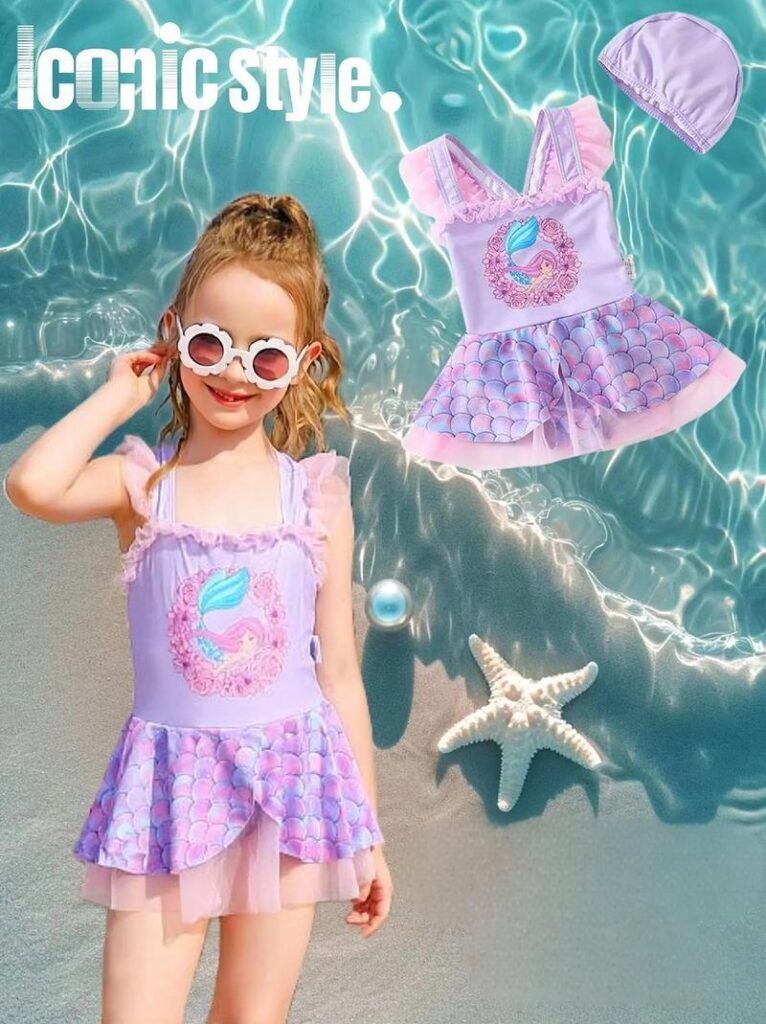
Chlorine, saltwater, and UV exposure are three of swimwear’s harshest enemies—each can break down fibers, fade colors, and destroy elasticity over time. Chlorine attacks polyamide chains, causing up to a 20% loss in tensile strength after just 50 hours in 5–10 ppm pools if unprotected. Saltwater’s minerals crystallize on fibers, increasing surface abrasion by 5–10%, while UV rays cleave polymer backbones and degrade dyes, cutting strength by 15–20% after 200 kJ/m² exposure. Swim fabrics treated with anti-chlorine finishes, hydrophobic rinses, and HALS UV stabilizers retain over 90% of their original performance through repeated use, ensuring suits stay supportive and vibrant for far longer.
Environmental Stress Tests & Protective Treatments
- Chlorine Degradation Exposure Time Unprotected Tensile Retention (%) Treated Fabric Retention (%) 25 hours 80–85 90–92 50 hours 70–75 88–90 – Treatment: Quaternary ammonium anti-chlorine baths form a protective barrier around polyamide fibers, extending life by 1.5–2×
- Saltwater Abrasion Salt Cycles Abrasion Increase (%) Recovery in Rinse (%) 10 cycles 3–5 95 50 cycles 8–10 90 – Treatment: Hydrophobic surfactant finishes reduce mineral deposition and ease rinsing, cutting abrasive damage in half.
- UV Exposure UV Dose (kJ/m²) Strength Retention (%) Color ΔE (Max) 100 85–90 <2.0 200 75–80 <3.5 – Treatment: Hindered amine light stabilizers (HALS) at 0.5–1% preserve polymer integrity and dye stability, halving degradation rates.
While each protective finish can significantly extend swimwear life, over-application may stiffen the hand or reduce stretch. Optimal formulation balances additive loading with fabric flexibility, and brands should validate treatments through both lab tests and real-world wear trials to ensure true longevity under combined chlorine, salt, and sun exposure.
How Do Moisture-Wicking, Quick-Dry, and Breathability Properties Enhance Swimmer Comfort?
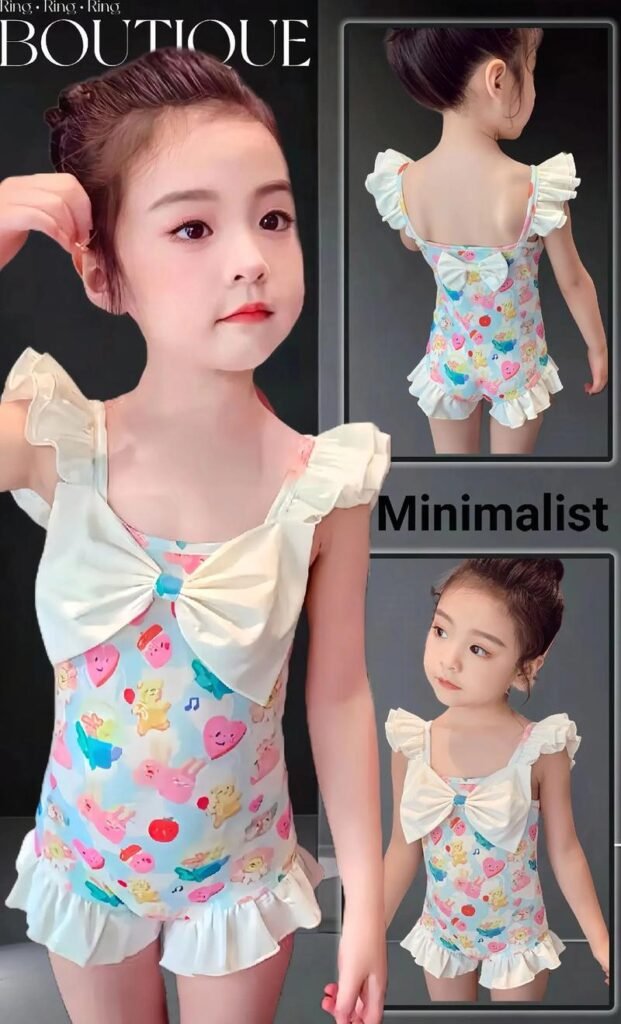
When swimmers exit the pool or surf the waves, a suit that clings wet for minutes can lead to chills and chafing. Moisture-wicking fabrics draw residual water and sweat away from the skin; quick-dry finishes accelerate evaporation; and high breathability allows air to circulate, reducing dampness and irritation. Together, these features maintain thermal comfort on deck, prevent bacterial growth, and support back-to-back training or competition. Top-tier swimwear fabrics achieve wicking rates of 0.8–1.2 cm/s, dry in 5–8 minutes post-swim, and have MVTR values above 8,000 g/m²·24 h. These metrics ensure that water is rapidly transported to the surface and evaporated, while air permeates the suit, keeping athletes warm, dry, and comfortable between sessions.
Moisture Management Technologies & Metrics
Wicking Rate & Capillary Action Fabric Finish Wicking Rate (cm/s) Dry Time (min) Untreated Nylon/PBT 0.4–0.6 10–15 Hydrophilic Yarn Finish 0.8–1.2 5–8 Mesh-Vent Panels 1.3–1.6 4–6
MVTR (Moisture Vapor Transmission Rate) Fabric Construction MVTR (g/m²·24 h) Standard Tricot 5,000–6,000 Hydrophilic Treated Tricot 8,000–9,000 Micro-Tricot with Laser-Cut Vents 10,000–12,000
Breathability vs. Water Barrier
- Unlike outdoor gear, swimwear doesn’t require waterproofing; prioritizing open knits and low-coating finishes ensures maximal airflow and rapid drying.
Critical Lens:
- Durability of Finishes: Hydrophilic treatments often degrade after 30–40 chlorine wash cycles; brands need to communicate care instructions or offer re-treatment options.
- Panel Integration: Strategic placement of mesh or laser-cut ventilation in low-stress zones can boost comfort without sacrificing compression or drag performance.
By combining advanced fiber finishes with intelligent knit design, swimwear fabrics deliver a dry, lightweight feel that supports athlete recovery and comfort—proving that performance extends well beyond the water itself.
Are Sustainable and Recycled Swimwear Fabrics Keeping Pace with Performance Requirements?
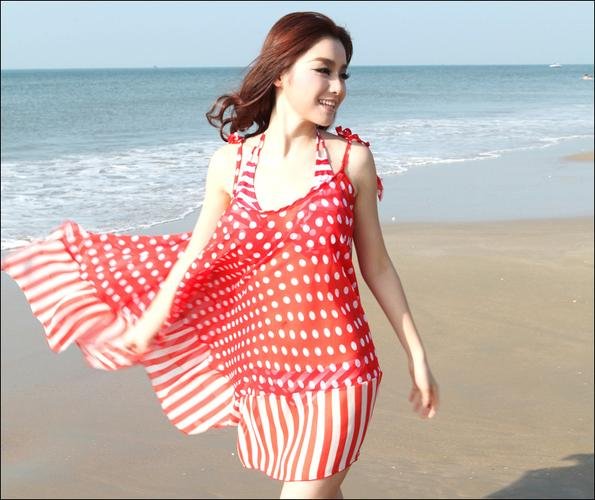
Yes—modern sustainable swim fabrics, such as recycled nylon/PBT (80/20) and recycled polyester/PBT (75/25) blends, now match or closely approach virgin‐fiber performance. Recycled nylon/PBT delivers tenacity of 580–780 MPa, 40–55 % elongation, and 90–95 % strength retention after 100 h in chlorinated water. Recycled polyester/PBT offers superior UV and chlorine resistance with 30–45 % elongation and 92–96 % recovery. Certified by GRS and RCS, these materials provide both eco‐credentials and the stretch, recovery, and durability essential for high‐performance swimsuits.
Circular Materials & Performance Metrics
1. Mechanical Performance Comparison
| Blend | Tenacity (MPa) | Elongation at Break (%) | Elastic Recovery @15% (%) | Chlorine Retention @100 h (%) |
|---|---|---|---|---|
| 80 rPA6 / 20 PBT | 580–780 | 40–55 | 90–95 | 88–92 |
| 75 rPET / 25 PBT | 500–700 | 30–45 | 92–96 | 90–94 |
| Virgin PA6 / 20 PBT | 600–800 | 50–60 | 95–98 | 80–85 |
| Virgin PET / 25 PBT | 550–750 | 35–50 | 90–94 | 90–95 |
- Key Insight: Recycled blends achieve 90–95 % of virgin performance in stretch, recovery, and chlorine durability.
2. Certification & Traceability
| Standard | Scope | Minimum Requirement |
|---|---|---|
| Global Recycle Standard (GRS) | Verifies recycled content & environmental/social practices | ≥20 % recycled content, chain‐of‐custody |
| Recycled Claim Standard (RCS) | Tracks percentage of recycled material in final product | ≥50 % verified recycled material |
| OEKO-TEX® Standard 100 | Limits harmful substances | Compliance with strict chemical limits |
- Opt for physically segregated certified streams to maximize content integrity.
3. Supply Constraints & Economic Considerations
- MOQs: Typically 1,000 m per color/quality for recycled blends—plan collections to consolidate SKUs.
- Cost Premium: Expect 10–20 % above virgin equivalents; economies of scale are improving as demand rises.
- Lead Times: Recycled‐blend mills often require 45–60 days, versus 30–45 for virgin.
4. Critical Lens: Risks & Opportunities
- Batch Variability: Recycled feedstocks can introduce fluctuations in intrinsic viscosity (IV) and color—mandate strict QC (IV ±0.02 dL/g).
- Microfiber Release: Recycled synthetics may shed microplastics; consider fabric finishes or garment labels recommending microfiber filters.
- Greenwashing Pitfalls: Claims must specify certified recycled percentages and include certification numbers on tech packs.
By integrating rigorously tested, certified recycled nylon and polyester blends, swimwear brands can deliver the stretch, recovery, and durability that athletes demand—while reducing reliance on virgin polymers and closing the loop on plastic waste.
Which Finishes and Treatments—Such as PBT Blends, DWR Coatings, and UV Inhibitors—Maximize Fabric Performance?
Optimizing swimwear performance hinges on smart finishes: PBT fiber incorporation (15–25 %) ensures >95 % elastic recovery and sustained compression; durable water-repellent (DWR) coatings (5–10 g/m² fluorine-free) promote quick-drying with a ≥110° contact angle for 20–30 washes; and UV inhibitors (HALS at 0.5–1 % loading) preserve over 85 % tensile strength and minimize color fading (ΔE<2) after 200 kJ/m² exposure. These targeted treatments extend suit life, maintain fit, and keep athletes comfortable and protected from sun and pool chemicals.
Finish Chemistry & Application Metrics
PBT Fiber Blends
- Blend Ratios: 15 % PBT yields 90–93 % recovery; 25 % PBT pushes recovery to 95–98 %.
- Application: PBT spun into core-sheath yarns or blended as staple.
- Benefit: Prevents “bagging” after repeated use; enhances compression durability.
DWR Coatings (Fluorine-Free) Metric Target Value Water Contact Angle ≥110° Add-on Weight 5–10 g/m² Wash Durability 20–30 cycles Impact on Drag Coefficient <1 % increase
- Methods: Pad-dry cures at 140 °C preserve hand feel.
- Trade-Offs: Excessive add-on (>15 g/m²) stiffens fabric and can increase drag.
UV Stabilization (HALS & UV Absorbers) Treatment Loading (%) Strength Retention @200 kJ/m² (%) Color ΔE HALS (Hindered Amine) 0.5–1 ≥85 <2.0 Benzotriazole UV Absorber 0.2–0.5 ≥80 <2.5
- Incorporation: Melt compounding or exhaust bath.
- Benefit: Shields fibers and dyes from photodegradation in outdoor applications.
Anti-Chlorine and Anti-Salt Treatments
- Quaternary Ammonium Finishes: 1–3 % bath imparts >90 % tensile retention after 100 h in 10 ppm chlorine.
- Hydrophobic Rinse-Off Aids: Lowers water uptake by 30 %, reducing mineral crystallization from salt.
Critical Lens:
- Finish Synergy: Combining UV, chlorine, and water-repellent treatments requires careful compatibility testing to avoid finish interference.
- Hand-Feel Preservation: Opt for low-add-on, high-efficiency chemistries to maintain fabric softness and stretch.
- Environmental Considerations: Select OEKO-TEX® or bluesign®approved finishes to ensure chemical safety and minimize ecological impact.
By integrating these specialized treatments—PBT blending for recovery, DWR coatings for rapid drying, and UV/chlorine inhibitors for longevity—swimwear manufacturers can craft suits that perform at the highest level without compromising comfort or durability.
How Do Cost, Minimum Order Quantities, and Supplier Capabilities Shape Your Swimwear Fabric Selection?
Technical swimwear fabrics range from \$6–\$12 per meter, with minimum order quantities (MOQs) of 500–1,000 meters per color or quality. Rapid‐sampling programs (100–200 m) may carry a 20–30% price premium. Suppliers like Szoneier Fabrics that offer in-house lab testing, low-MOQ sampling, and design consultation can dramatically reduce development time and risk, enabling brands to balance budget, time-to-market, and fabric performance requirements.
Economic & Operational Trade-Offs
Unit Cost vs. Quality Tier Fabric Type Cost (USD/m) MOQ (m) Lead Time (days) Standard Nylon/PBT 6–8 1,000 30–45 Premium Polyester/PBT 7–9 1,000 30–45 Recycled Nylon/PBT (rPA6) 8–10 1,000 45–60 Low-MOQ Sampling (any) 7–10 (+20%) 100–200 10–15
- Trade-off: Lower upfront investment with sampling versus economies of scale on larger orders.
Supplier Capabilities & Value-Adds
- In-House Testing: Tensile, chlorine, UV, and cyclical stretch labs ensure fabrics meet spec before bulk production.
- Design Support: Free panel layout, seam placement, and stitch recommendations reduce prototyping cycles.
- Quality Certifications: ISO 9001, OEKO-TEX® Standard 100, and GRS/RCS validate consistency and eco-credentials.
Time-to-Market Considerations Stage Typical Duration Sample Request & Delivery 10–15 days Lab Testing & Feedback 7–10 days Bulk Production 30–45 days (virgin) 45–60 days (recycled)
- Agile Suppliers: Those offering rapid prototyping and flexible production windows can secure seasonal launch dates.
Critical Lens:
- Balancing Cost and Performance: Cheaper fabrics may underperform in stretch or chlorine resistance, leading to higher downstream returns or reorders.
- MOQ Strategy: Consolidating colors or slight performance tiers into a single production run can meet MOQs without overstocking.
- Supplier Partnerships: Long-term relationships with capable mills enable better pricing, priority capacity, and collaborative innovation—crucial for brands demanding cutting-edge swim technologies.
By carefully weighing fabric unit cost, MOQ requirements, and supplier services, swimwear brands can optimize their material investment—ensuring top-tier performance without compromising profitability or launch schedules.
Ready to elevate your swimwear line with custom high-performance fabrics?
Selecting the best swimwear fabric is a multidimensional challenge—balancing fiber science, knit engineering, environmental resistance, and economic realities. By focusing on nylon/PBT or polyester/PBT blends, optimized knit constructions, and targeted finishes (anti-chlorine, UV, hydrophilic), brands can deliver suits that excel in performance, comfort, and longevity.
Partner with Szoneier Fabrics for expert R&D, design support, low-MOQ sampling, fast prototyping, and guaranteed quality.

